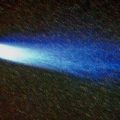
Amino acids have been found in interstellar clouds and in meteorites – but with some enigmatic omissions and tantalizing similarities to life on Earth. Just why some amino acids are present in meteorites and others are absent, and why they seem to prefer the same “left-handed” molecular structure as Earth’s living amino acids are questions that could unravel one of the most fundamental questions of science: Where and how did life begin?
“The bottom line is that you have these materials that come from space,” says Steve Macko, professor of environmental sciences at the University of Virginia in Charlottesville. Macko refers specifically to eight of the amino acids found in a certain kind of meteorite – a carbonaceous chondrite. All eight amino acids are identical to those used by life on Earth. That could seem to point to a cosmic origin of these basic biological building blocks, says Macko. The case is bolstered by the fact that early Earth was bombarded with meteorites and the amino acid glycine has been detected on interstellar molecular clouds.
The implications and enigmas of extraterrestrial amino acids will be detailed at the annual meeting of the Geological Society of America in Seattle.
“Essentially all of your protein is made of L-amino acids,” said Macko. “Why is that? We don’t know. The curious thing is that if you go to a meteorite you find a predominance of the same thing.”
Another unanswered question: Why have only eight of life’s 20 amino acids been found in meteorites? Perhaps all the amino acids were there, but something about the history of the meteorites or the analytical processes used limited their presence or their detection, Macko speculates.
Only in recent years has the idea of amino acids from space affecting the start of life on Earth become a plausible hypothesis, explains Macko. Initially, amino acids were thought to have been created in the primordial atmosphere of early Earth. In a now famous experiment more than a half-century ago, Stanley Miller and Harold Urey showed that amino acids were synthesized by simply creating lightning-like electrical discharges through a fog of water, methane and ammonia – all of which were thought to be readily available in Earth’s early years. The experiment was proof that amino acids, out of which all life’s proteins are made, can be created by strictly physical-chemical processes, without the help of living organisms.
Perhaps the most famous carbonaceous chondrite was the Murchison meteorite, which fragmented and fell in 1969 in and around the small town of Murchison, Victoria, about 70 miles north of Melbourne, Australia. Amino acids and other organic molecules were found in the Murchison meteorite. The mix of amino acids found in the Murchison Meteorite was similar to those produced in Miller-Urey type experiments. A chief difference, however, was seen by Mike Engel in his PhD research: Unlike the Miller-Urey experiment which produced equal amounts of the D and L- amino acids, Murchison tended to have l-amino acids predominate. The fact that the meteorite was seen falling and fragments were collected quickly minimized the chances that they were contaminated by Earth amino acids.
The Miller-Urey experiment, combined with the discovery of amino acids in carbonaceous chondrites and the detection of glycine in molecular clouds, raise compelling issues about the origin of life on Earth, and its possible existence elsewhere in the solar system and beyond.

















Comments are closed.